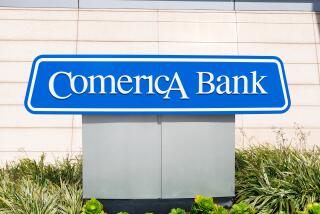Big Bank Failures Called Threat to FDIC
WASHINGTON — The severe slump in commercial real estate is making the outlook increasingly grim for the banking industry, with several big institutions likely to fail next year, driving the federal insurance fund for deposits into a deep deficit, Federal Deposit Insurance Corp. Chairman L. William Seidman warned Congress on Thursday.
As the tide of bank failures mounts in 1992, the insurance fund, which protects deposits up to $100,000, will be badly weakened, facing a deficit of $11 billion by the year’s end. This grim assessment was far worse than Seidman’s January forecast of $4.6 billion and is new evidence that there is no sign of improvement in the vacancy rates for office buildings and shopping centers financed by bank loans.
None of the nation’s biggest banks--the money center banks--is expected to fail, Seidman after the hearing, offering reassurance without citing any specific names. But the anticipated insolvencies probably will come among substantial institutions in the East, the region hardest hit by the deep plunge in the commercial real estate market, he indicated.
The $11-billion “pessimistic” deficit estimate for the insurance fund could grow even larger if the commercial real estate markets keep declining in California and the Southeast, Seidman told the House Budget Committee.
“We have built 1993’s buildings in 1989,” he said. “Whether we have greater problems will depend on the economy, particularly the California economy.”
However, California’s market is still in much better shape than New England, with far fewer loans overdue or in default, and the FDIC field experts do not expect a slump comparable to the situation in New England, Seidman said .
Banks are being crippled by their heavy dependence on loans for construction and development of commercial real estate, which has become the biggest source of business for the American banking system.
In an effort to reduce this dependence, Congress is working on legislation proposed by the Bush Administration to enact the most sweeping changes in banking law since the Great Depression, giving banks the power to cross state lines without restrictions and to enter fully into the business of securities and insurance.
The House Banking Committee is expected to finish work today on its version of the legislation, giving the Administration most of its requests, including a controversial provision to allow commercial and industrial firms to own banks. But the legislation faces an uncertain future when the provisions dealing with securities and insurance will be considered in the Energy and Commerce Committee.
The Bush Administration has argued strongly that these new business powers for the banks would revitalize and strengthen the industry, making it strong enough to withstand future crises.
“When comprehensive reform is achieved, we believe the deposit insurance fund will return to being little more than an asterisk in the federal budget,” Treasury Undersecretary Robert R. Glauber told the budget committee hearing.
The banking legislation would give the FDIC $70 billion in new borrowing authority to deal with the cost of closing failed banks and paying off the insured deposits. The money would provide the contingency support if bank failures keep accelerating.
Seidman wants a big line of credit ready because he is increasingly worried about the future. In less than six months, his “pessimistic” forecast of the fund’s anticipated 1992 deficit has more than doubled.
The bank insurance fund will be solvent at the end of this year, with an expected balance of $3.2 billion, only through the device of extensive borrowing, Seidman testified.
Times staff writer James Risen contributed to this story.
More to Read
Inside the business of entertainment
The Wide Shot brings you news, analysis and insights on everything from streaming wars to production — and what it all means for the future.
You may occasionally receive promotional content from the Los Angeles Times.










